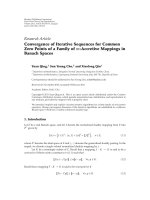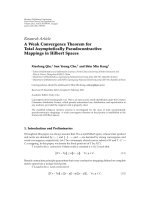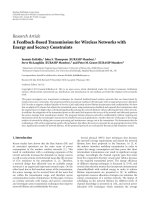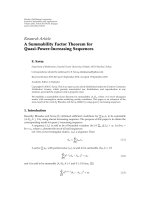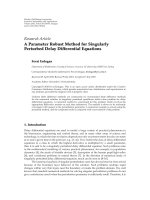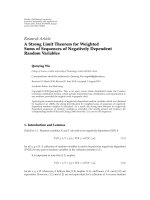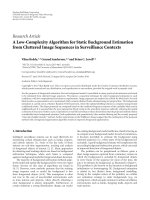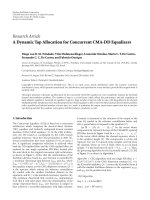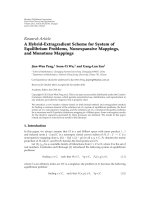Báo cáo hóa học: " Research Article A Hybrid Iterative Scheme for Equilibrium Problems, Variational Inequality Problems, and Fixed Point Problems in Banach Spaces" docx
Bạn đang xem bản rút gọn của tài liệu. Xem và tải ngay bản đầy đủ của tài liệu tại đây (536.41 KB, 18 trang )
Hindawi Publishing Corporation
Fixed Point Theory and Applications
Volume 2009, Article ID 719360, 18 pages
doi:10.1155/2009/719360
Research Article
A Hybrid Iterative Scheme for Equilibrium
Problems, Variational Inequality Problems, and
Fixed Point Problems in Banach Spaces
Prasit Cholamjiak
School of Science and Technology, Naresuan University at Phayao, Phayao 56000, Thailand
Correspondence should be addressed to Prasit Cholamjiak,
Received 5 February 2009; Accepted 10 April 2009
Recommended by Simeon Reich
The purpose of this paper is to introduce a new hybrid projection algorithm for finding a
common element of the set of solutions of the equilibrium problem and the set of the variational
inequality for an inverse-strongly monotone operator and the set of fixed points of relatively quasi-
nonexpansive mappings in a Banach space. Then we show a strong convergence theorem. Using
this result, we obtain some applications in a Banach space.
Copyright q 2009 Prasit Cholamjiak. This is an open access article distributed under the Creative
Commons Attribution License, which permits unrestricted use, distribution, and reproduction in
any medium, provided the original work is properly cited.
1. Introduction
Let E be a real Banach space and let E
∗
be the dual of E.LetC be a closed convex subset of E.
Let A : C → E
∗
be an operator. The classical variational inequality problem for A is to find
x ∈ C such that
Ax, y − x≥0, ∀y ∈ C. 1.1
The set of solutions of 1.1 is denoted by VIA, C. Such a problem is connected with the
convex minimization problem, the complementarity, the problem of finding a point x ∈ E
satisfying 0 A x, and so on. First, we recall that
1 an operator A is called monotone if
Ax − Ay, x − y≥0, ∀x, y ∈ C. 1.2
2 Fixed Point Theory and Applications
2 an operator A is called α-inverse-strongly monotone if there exists a constant α>0
with
Ax − Ay, x − y≥α
Ax − Ay
2
, ∀x, y ∈ C. 1.3
Assume that
C1 A is α-inverse-strongly monotone,
C2 VIA, C
/
∅,
C3 Ay≤Ay − Au for all y ∈ C and u ∈ VIA, C.
Iiduka and Takahashi 1 introduced the following algorithm for finding a solution
of the variational inequality for an operator A that satisfies conditions C1–C3 in a 2-
uniformly convex and uniformly smooth Banach space E. For an initial point x
1
x ∈ C,
define a sequence {x
n
} by
x
n1
Π
C
J
−1
Jx
n
− λ
n
Ax
n
, ∀n ≥ 1, 1.4
where J is the duality mapping on E,andΠ
C
is the generalized projection from E onto
C. Assume that λ
n
∈ a, b for some a, b with 0 <a<b<c
2
α/2 where 1/c is the p-
uniformly convexity constant of E. They proved that if J is weakly sequentially continuous,
then the sequence {x
n
} converges weakly to some element z in VIA, C where z
lim
n →∞
Π
VIA,C
x
n
.
The problem of finding a common element of the set of the variational inequalities
for monotone mappings in the framework of Hilbert spaces and Banach spaces has been
intensively studied by many authors; see, for instance, 2–4 and t he references cited therein.
Let f : C × C → R be a bifunction. The equilibrium problem for f is to find x ∈ C such
that
f
x, y
≥ 0, ∀y ∈ C. 1.5
The set of solutions of 1.5 is denoted by EPf.
For solving the equilibrium problem, let us assume that a bifunction f satisfies the
following conditions:
A1 fx, x0 for all x ∈ C;
A2 f is monotone, that is, fx, yfy, x ≤ 0 for all x, y ∈ C;
A3 for all x, y, z ∈ C,
lim sup
t↓0
f
tz
1 − t
x, y
≤ f
x, y
; 1.6
A4 for all x ∈ C, f x, · is convex and lower semicontinuous.
Fixed Point Theory and Applications 3
Recently, Takahashi and Zembayashi 5, introduced the following iterative scheme
which is called the shrinking projection method:
x
0
x ∈ C, C
0
C,
y
n
J
−1
α
n
Jx
n
1 − α
n
JTx
n
,
u
n
∈ C such that f
u
n
,y
1
r
n
y − u
n
,Ju
n
− Jy
n
≥0, ∀y ∈ C,
C
n1
z ∈ C
n
: φ
z, u
n
≤ φ
z, x
n
,
x
n1
Π
C
n1
x
0
, ∀n ≥ 0,
1.7
where J is the duality mapping on E and Π
C
is the generalized projection from E onto C. They
proved that the sequence {x
n
} converges strongly to q Π
FT∩EPf
x
0
under appropriate
conditions.
Very recently, Qin et al. 6 extend the iteration process 1.7 from a single relatively
nonexpansive mapping to two relatively quasi-nonexpansive mappings:
x
0
∈ E, chosen arbitrarily,
C
1
C, x
1
Π
C
1
x
0
,
y
n
J
−1
α
n
Jx
n
β
n
JTx
n
γ
n
JSx
n
,
u
n
∈ C such that f
u
n
,y
1
r
n
y − u
n
,Ju
n
− Jy
n
≥0, ∀y ∈ C,
C
n1
z ∈ C
n
: φ
z, u
n
≤ φ
z, x
n
,
x
n1
Π
C
n1
x
0
.
1.8
Under suitable conditions over {α
n
}, {β
n
},and{γ
n
}, they obtain that the sequence {x
n
}
generated by 1.8 converges strongly to q Π
FT∩FS∩EPf
x
0
.
The problem of finding a common element of the set of fixed points and the set of
solutions of an equilibrium problem in the framework of Hilbert spaces and Banach spaces
has been studied by many authors; see 5, 7–16.
Motivated by Iiduka and Takahashi 1, Takahashi and Zembayashi 5, and Qin
et al. 6, we introduce a new general process for finding common elements of the set of
the equilibrium problem and the set of the variational inequality problem for an inverse-
strongly monotone operator and the set of the fixed points for relatively quasi-nonexpansive
mappings.
4 Fixed Point Theory and Applications
2. Preliminaries
Let E be a real Banach space and let U {x ∈ E : x 1} be the unit sphere of E. A Banach
space E is said to be strictly convex if for any x, y ∈ U,
x
/
y implies
x y
2
< 1. 2.1
It is also said to be uniformly convex if for each ε ∈ 0, 2, t here exists δ>0 such that for any
x, y ∈ U,
x − y
≥ ε implies
x y
2
< 1 − δ. 2.2
It is known that a uniformly convex Banach space is reflexive and strictly convex; and we
define a function δ : 0, 2 → 0, 1 called the modulus of convexity of E as follows:
δ
ε
inf
1 −
x y
2
: x, y ∈ E,
x
y
1,
x − y
≥ ε
. 2.3
Then E is uniformly convex if and only if δε > 0 for all ε ∈ 0, 2.Letp be a fixed real
number with p ≥ 2. A Banach space E is said to be p-uniformly convex if there exists a constant
c>0 such that δε ≥ cε
p
for all ε ∈ 0, 2;see17–19 for more details. A Banach space E is
said to be smooth if the limit
lim
t → 0
x ty
−
x
t
2.4
exists for all x, y ∈ U.Itisalsosaidtobeuniformly smooth if the limit 2.4 is attained
uniformly for x,y ∈ U. One should note that no Banach space is p-uniformly convex for
1 <p<2; see 19. It is well known that a H ilbert space is 2-uniformly convex, uniformly
smooth. For each p>1, the generalized duality mapping J
p
: E → 2
E
∗
is defined by
J
p
x
x
∗
∈ E
∗
: x, x
∗
x
p
,
x
∗
x
p−1
2.5
for all x ∈ E. In particular, J J
2
is called the normalized duality mapping.IfE is a Hilbert space,
then J I, where I is the identity mapping. It is also known that if E is uniformly smooth,
then J is uniformly norm-to-norm continuous on each bounded subset of E.See20, 21 for
more details.
Lemma 2.1 See 18, 22. Let p be a given real number with p ≥ 2 and E a p-uniformly convex
Banach space. Then, for all x, y ∈ E, j
x
∈ J
p
x and j
y
∈ J
p
y,
x − y, j
x
− j
y
≥
c
p
2
p−2
p
x − y
p
, 2.6
where J
p
is the generalized duality mapping of E and 1/c is the p-uniformly convexity constant of E.
Fixed Point Theory and Applications 5
Let E be a smooth Banach space. The function φ : E × E → R is defined by
φ
x, y
x
2
− 2x, Jy
y
2
2.7
for all x, y ∈ E. In a Hilbert space H, we have φx, yx − y
2
for all x, y ∈ H.
Recall that a mapping T : C → C is called nonexpansive if Tx − Ty≤x − y for all
x, y ∈ C and relatively nonexpansive if T satisfies the following conditions:
1 FT
/
∅, where FT is the set of fixed points of T;
2 φp, Tx ≤ φp, x for all p ∈ FT and x ∈ C;
3 F
TFT, where F
T is the set of all asymptotic fixed points of T;
see 10, 23, 24 for more details.
T
is said to be relatively quasi-nonexpansive if T satisfies the conditions 1 and 2.It
is easy to see that the class of relatively quasi-nonexpansive mappings is more general than
the class of relatively nonexpansive mappings 9, 25, 26.
We give some examples which are closed relatively quasi-nonexpansive; see 6.
Example 2.2. Let E be a uniformly smooth and strictly convex Banach space and A ⊂ E × E
∗
be a maximal monotone mapping such that its zero set A
−1
0
/
∅. Then, J
r
J rA
−1
J is a
closed relatively quasi-nonexpansive mapping from E onto DA and FJ
r
A
−1
0.
Example 2.3. Let Π
C
be the generalized projection from a smooth, strictly convex, and
reflexive Banach space E onto a nonempty closed convex subset C of E. Then, Π
C
is a closed
relatively quasi-nonexpansive mapping with FΠ
C
C.
Lemma 2.4 Kamimura and Takahashi 27. Let E be a uniformly convex and smooth Banach
space and let {x
n
}, {y
n
} be two sequences of E.Ifφx
n
,y
n
→ 0 and either {x
n
} or {y
n
} is bounded,
then x
n
− y
n
→0 as n →∞.
Let C be a nonempty closed convex subset of E.IfE is reflexive, strictly convex and
smooth, then there exists x
0
∈ C such that φx
0
,xminφy, x for x ∈ E and y ∈ C.The
generalized projection Π
C
: E → C defined by Π
C
x x
0
. The existence and uniqueness of
the operator Π
C
follows from the properties of the functional φ and strict monotonicity of the
duality mapping J; for instance, see 20, 27–30. In a Hilbert space, Π
C
is coincident with the
metric projection.
Lemma 2.5 Alber 28. Let C be a nonempty closed convex subset of a s mooth Banach space E and
x ∈ E.Thenx
0
Π
C
x if and only if x
0
− y, Jx − Jx
0
≥0 for all y ∈ C.
Lemma 2.6 Alber 28. Let C be a nonempty closed convex subset of a reflexive, strictly convex
and smooth Banach space E and let x ∈ E.Then
φ
y, Π
C
x
φ
Π
C
x, x
≤ φ
y, x
, ∀y ∈ C. 2.8
Lemma 2.7 Qin et al. 6. Let E be a uniformly convex, smooth Banach space, let C be a closed
convex subset of E,letT be a closed and relatively quasi-nonexpansive mapping from C into itself.
Then FT is a closed convex subset of C.
6 Fixed Point Theory and Applications
Lemma 2.8 Cho et al. 31. Let E be a uniformly convex Banach space and let B
r
0 be a closed
ball of E. Then there exists a continuous strictly increasing convex function g : 0, ∞ → 0, ∞
with g00 such that
αx βy γz
2
≤ α
x
2
β
y
2
γ
z
2
− αβg
x − y
, 2.9
for all x, y, z ∈ B
r
0, and α, β, γ ∈ 0, 1 with α β γ 1.
Lemma 2.9 Blum and Oettli 7. Let C be a closed convex subset of a smooth, strictly convex, and
reflexive Banach space E,letf be a bifunction from C × C to R satisfying (A1)–(A4), and let r>0
and x ∈ E. Then, there exists z ∈ C such that
f
z, y
1
r
y − z, Jz − Jx≥0, ∀y ∈ C. 2.10
Lemma 2.10 Qin et al. 6. Let C be a closed convex subset of a uniformly smooth, strictly convex,
and reflexive Banach space E, and let f be a bifunction from C × C to R satisfying (A1)–(A4). For all
r>0 and x ∈ E, define a mapping T
r
: E → C as follows:
T
r
x
z ∈ C : f
z, y
1
r
y − z, Jz − Jx≥0, ∀y ∈ C
. 2.11
Then, the following hold:
1 T
r
is single-valued;
2 T
r
is a firmly nonexpansive-type mapping [32], that is, for all x, y ∈ E,
T
r
x − T
r
y, JT
r
x − JT
r
y≤T
r
x − T
r
y, Jx − Jy; 2.12
3 FT
r
EPf;
4 EPf is closed and convex.
Lemma 2.11 Takahashi and Zembayashi 14. Let C be a closed convex subset of a smooth,
strictly, and reflexive Banach space E,letf be a bifucntion from C × C to R satisfying (A1)–(A4), let
r>0. Then, for all x ∈ E and q ∈ FT
r
,
φ
q, T
r
x
φ
T
r
x, x
≤ φ
q, x
. 2.13
We make use of the following mapping V studied in Alber 28:
V
x, x
∗
x
2
− 2x, x
∗
x
∗
2
2.14
for all x ∈ E and x
∗
∈ E
∗
,thatis,V x, x
∗
φx, J
−1
x
∗
.
Fixed Point Theory and Applications 7
Lemma 2.12 Alber 28. Let E be a reflexive, strictly convex, smooth Banach space and let V be as
in 2.14.Then
V
x, x
∗
2J
−1
x
∗
− x, y
∗
≤V
x, x
∗
y
∗
2.15
for all x ∈ E and x
∗
,y
∗
∈ E
∗
.
An operator A of C into E
∗
is said to be hemicontinuous if for all x, y ∈ C, the mapping
F of 0, 1 into E
∗
defined by FtAtx 1 − ty is continuous with respect to the weak
∗
topology of E
∗
. We define by N
C
v the normal cone for C at a point v ∈ C,thatis,
N
C
v
x
∗
∈ E
∗
: v − y, x
∗
≥0, ∀y ∈ C
. 2.16
Theorem 2.13 Rockafellar 33. Let C be a nonempty, closed convex subset of a Banach space E
and A a monotone, hemicontinuous operator of C into E
∗
.LetT
e
⊂ E × E
∗
be an operator defined as
follows:
T
e
v
⎧
⎨
⎩
Av N
C
v
,v∈ C;
∅, otherwise.
2.17
Then T
e
is maximal monotone and T
−1
e
0 VIA, C.
3. Strong Convergence Theorems
Theorem 3.1. Let E be a 2-uniformly convex, uniformly smooth Banach space, let C be a nonempty
closed convex subset of E.Letf be a bifunction from C × C to R satisfying (A1)–(A4), let A be an
operator of C into E
∗
satisfying (C1)–(C3), and let T,S be two closed relatively quasi-nonexpansive
mappings from C into itself such that F : FT ∩ FS ∩EPf ∩ VIA, C
/
∅. For an initial point
x
0
∈ E with x
1
Π
C
1
x
0
and C
1
C, define a sequence {x
n
} as follows:
z
n
Π
C
J
−1
Jx
n
− λ
n
Ax
n
,
y
n
J
−1
α
n
Jx
n
β
n
JTx
n
γ
n
JSz
n
,
u
n
∈ C such that f
u
n
,y
1
r
n
y − u
n
,Ju
n
− Jy
n
≥0, ∀y ∈ C,
C
n1
z ∈ C
n
: φ
z, u
n
≤ φ
z, x
n
,
x
n1
Π
C
n1
x
0
, ∀n ≥ 1,
3.1
where J is the duality mapping on E. Assume that {α
n
}, {β
n
}, and {γ
n
} are sequences in 0, 1
satisfying the restrictions:
B1 α
n
β
n
γ
n
1;
B2 lim inf
n →∞
α
n
β
n
> 0, lim inf
n →∞
α
n
γ
n
> 0;
8 Fixed Point Theory and Applications
B3 {r
n
}⊂s, ∞ for some s>0;
B4 {λ
n
}⊂a, b for some a, b with 0 <a<b<c
2
α/2,where1/c is the 2-uniformly
convexity constant of E.
Then, {x
n
} and {u
n
} converge strongly to q Π
F
x
0
.
Proof. We divide the proof into eight steps.
Step 1. Show that Π
F
x
0
and Π
C
n1
x
0
are well defined.
It is obvious that VIA, C is a closed convex subset of C.ByLemma 2.7,weknowthat
FT ∩ FS is closed and convex. From Lemma 2.10 4, we also have EPf is closed and
convex. Hence F : FT ∩ FS ∩ EPf ∩ VIA, C is a nonempty, closed, and convex subset
of C; consequently, Π
F
x
0
is well defined.
Clearly, C
1
C is closed and convex. Suppose that C
k
is closed and convex for k ∈ N.
For all z ∈ C
k
,weknowφz, y
k
≤ φz, x
k
is equivalent to
2z, Jx
k
− Jy
k
≤
x
k
2
−
y
k
2
. 3.2
So, C
k1
is closed and convex. By induction, C
n
is closed and convex for all n ≥ 1. This shows
that Π
C
n1
x
0
is well-defined.
Step 2. Show that F ⊂ C
n
for all n ∈ N.
Put v
n
J
−1
Jx
n
− λ
n
Ax
n
. First, we observe that u
n
T
r
n
y
n
for all n ≥ 1andF ⊂ C
1
C. Suppose F ⊂ C
k
for k ∈ N. Then, for all u ∈ F,weknowfromLemma 2.6 and Lemma 2.12
that
φ
u, z
k
φ
u, Π
C
v
k
≤ φ
u, v
k
φ
u, J
−1
Jx
k
− λ
k
Ax
k
V
u, Jx
k
− λ
k
Ax
k
≤ V
u,
Jx
k
− λ
k
Ax
k
λ
k
Ax
k
− 2
J
−1
Jx
k
− λ
k
Ax
k
− u, λ
k
Ax
k
V
u, Jx
k
− 2λ
k
v
k
− u, Ax
k
φ
u, x
k
− 2λ
k
x
k
− u, Ax
k
2v
k
− x
k
, −λ
k
Ax
k
.
3.3
Since u ∈ VIA, C and from C1, we have
−2λ
k
x
k
− u, Ax
k
−2λ
k
x
k
− u, Ax
k
− Au−2λ
k
x
k
− u, Au
≤−2αλ
k
Ax
k
− Au
2
.
3.4
Fixed Point Theory and Applications 9
From Lemma 2.1 and C3,weobtain
2v
k
− x
k
, −λ
k
Ax
k
2J
−1
Jx
k
− λ
k
Ax
k
− J
−1
Jx
k
, −λ
k
Ax
k
≤ 2
J
−1
Jx
k
− λ
k
Ax
k
− J
−1
Jx
k
λ
k
Ax
k
≤
4
c
2
JJ
−1
Jx
k
− λ
k
Ax
k
− JJ
−1
Jx
k
λ
k
Ax
k
4
c
2
Jx
k
− λ
k
Ax
k
−
Jx
k
λ
k
Ax
k
4
c
2
λ
2
k
Ax
k
2
≤
4
c
2
λ
2
k
Ax
k
− Au
2
.
3.5
Replacing 3.4 and 3.5 into 3.3,weget
φ
u, z
k
≤ φ
u, x
k
2λ
k
2
c
2
λ
k
− α
Ax
k
− Au
2
≤ φ
u, x
k
. 3.6
By the convexity of ·
2
, for each u ∈ F ⊂ C
k
,weobtain
φ
u, u
k
φ
u, T
r
k
y
k
≤ φ
u, y
k
φ
u, J
−1
α
k
Jx
k
β
k
JTx
k
γ
k
JSz
k
u
2
− 2α
k
u, Jx
k
−2β
k
u, JTx
k
−2γ
k
u, JSz
k
α
k
Jx
k
β
k
JTx
k
γ
k
JSz
k
2
≤
u
2
− 2α
k
u, Jx
k
−2β
k
u, JTx
k
−2γ
k
u, JSz
k
α
k
Jx
k
2
β
k
JTx
k
2
γ
k
JSz
k
2
α
k
φ
u, x
k
β
k
φ
u, Tx
k
γ
k
φ
u, Sz
k
≤ α
k
φ
u, x
k
β
k
φ
u, x
k
γ
k
φ
u, z
k
≤ φ
u, x
k
.
3.7
This shows that u ∈ C
k1
; consequently, F ⊂ C
k1
. Hence F ⊂ C
n
for all n ≥ 1.
Step 3. Show that lim
n →∞
φx
n
,x
0
exists.
From x
n
Π
C
n
x
0
and x
n1
Π
C
n1
x
0
∈ C
n1
⊂ C
n
, we have
φ
x
n
,x
0
≤ φ
x
n1
,x
0
, ∀n ≥ 1. 3.8
10 Fixed Point Theory and Applications
From Lemma 2.6, we have
φ
x
n
,x
0
φ
Π
C
n
x
0
,x
0
≤ φ
u, x
0
− φ
u, x
n
≤ φ
u, x
0
. 3.9
Combining 3.8 and 3.9, we obtain that lim
n →∞
φx
n
,x
0
exists.
Step 4. Show that {x
n
} is a Cauchy sequence in C.
Since x
m
Π
C
m
x
0
∈ C
m
⊂ C
n
for m>n,byLemma 2.6, we also have
φ
x
m
,x
n
φ
x
m
, Π
C
n
x
0
≤ φ
x
m
,x
0
− φ
Π
C
n
x
0
,x
0
φ
x
m
,x
0
− φ
x
n
,x
0
.
3.10
Taking m, n →∞,weobtainthatφx
m
,x
n
→ 0. From Lemma 2.4, we have x
m
− x
n
→0.
Hence {x
n
} is a Cauchy sequence. By the completeness of E and the closedness of C, one can
assume that x
n
→ q ∈ C as n →∞. Further, we obtain
lim
n →∞
φ
x
n1
,x
n
0. 3.11
Since x
n1
Π
C
n1
x
0
∈ C
n1
, we have
φ
x
n1
,u
n
≤ φ
x
n1
,x
n
−→ 0, 3.12
as n →∞. Applying Lemma 2.4 to 3.11 and 3.12,weget
lim
n →∞
u
n
− x
n
0. 3.13
This implies that u
n
→ q as n →∞. Since J is uniformly norm-to-norm continuous on
bounded subsets of E, we also obtain
lim
n →∞
Ju
n
− Jx
n
0. 3.14
Step 5. Show that x
n
→ q ∈ FT ∩ FS.
Fixed Point Theory and Applications 11
Let r sup
n≥1
{x
n
, Tx
n
, Sz
n
}.From3.6 and Lemma 2.8, we know that there
exists a continuous strictly increasing convex function g : 0, ∞ → 0, ∞ with g00 such
that
φ
u, u
n
φ
u, T
r
n
y
n
≤ φ
u, y
n
φ
u, J
−1
α
n
Jx
n
β
n
JTx
n
γ
n
JSz
n
u
2
− 2α
n
u, Jx
n
− 2β
n
u, JTx
n
− 2γ
n
u, JSz
n
α
n
Jx
n
β
n
JTx
n
γ
n
JSz
n
2
≤
u
2
− 2α
n
u, Jx
n
− 2β
n
u, JTx
n
− 2γ
n
u, JSz
n
α
n
Jx
n
2
β
n
JTx
n
2
γ
n
JSz
n
2
− α
n
β
n
g
Jx
n
− JTx
n
α
n
φ
u, x
n
β
n
φ
u, Tx
n
γ
n
φ
u, Sz
n
− α
n
β
n
g
Jx
n
− JTx
n
≤ φ
u, x
n
2γ
n
λ
n
2
c
2
λ
n
− α
Ax
n
− Au
2
− α
n
β
n
g
Jx
n
− JTx
n
.
3.15
This implies that
α
n
β
n
g
Jx
n
− JTx
n
≤ φ
u, x
n
− φ
u, u
n
x
n
2
−
u
n
2
− 2
u, Jx
n
− Ju
n
≤
x
n
− u
n
x
n
u
n
2
u
Jx
n
− Ju
n
.
3.16
It follows from 3.13, 3.14,andB2 that
lim
n →∞
g
Jx
n
− JTx
n
0. 3.17
By the property of g, we also obtain that
lim
n →∞
Jx
n
− JTx
n
0. 3.18
Since J is uniformly norm-to-norm continuous on bounded sets, so is J
−1
. Then
lim
n →∞
x
n
− Tx
n
lim
n →∞
J
−1
Jx
n
− J
−1
JTx
n
0. 3.19
12 Fixed Point Theory and Applications
In the same manner, we can show that
lim
n →∞
x
n
− Sz
n
0. 3.20
Again, by 3.15, we have
2a
α −
2
c
2
b
Ax
n
− Au
2
≤
1
γ
n
φ
u, x
n
− φ
u, u
n
, 3.21
which yields that
lim
n →∞
Ax
n
− Au
0. 3.22
From Lemma 2.6, Lemma 2.12,and3.5, we have
φ
x
n
,z
n
φ
x
n
, Π
C
v
n
≤ φ
x
n
,v
n
φ
x
n
,J
−1
Jx
n
− λ
n
Ax
n
V
x
n
,Jx
n
− λ
n
Ax
n
≤ V
x
n
,
Jx
n
− λ
n
Ax
n
λ
n
Ax
n
− 2J
−1
Jx
n
− λ
n
Ax
n
− x
n
,λ
n
Ax
n
φ
x
n
,x
n
2v
n
− x
n
, −λ
n
Ax
n
2v
n
− x
n
, −λ
n
Ax
n
≤
4
c
2
b
2
Ax
n
− Au
2
.
3.23
It follows from Lemma 2.4 and 3.22 that
lim
n →∞
x
n
− z
n
0. 3.24
Hence z
n
→ q as n →∞and
lim
n →∞
Jx
n
− Jz
n
0. 3.25
Combining 3.20 and 3.24, we also obtain
lim
n →∞
Sz
n
− z
n
0. 3.26
From 3.19, 3.26 and by the closedness of T and S,wegetq ∈ FT ∩ FS.
Fixed Point Theory and Applications 13
Step 6. Show that x
n
→ q ∈ EPf.
From 3.15,wesee
φ
u, y
n
≤ φ
u, x
n
. 3.27
From 3.16, we observe
lim
n →∞
φ
u, x
n
− φ
u, u
n
0. 3.28
Note that u
n
T
r
n
y
n
.From3.27 and Lemma 2.11, we have
φ
u
n
,y
n
φ
T
r
n
y
n
,y
n
≤ φ
u, y
n
− φ
u, T
r
n
y
n
≤ φ
u, x
n
− φ
u, T
r
n
y
n
φ
u, x
n
− φ
u, u
n
.
3.29
From 3.28, we get lim
n →∞
φu
n
,y
n
0. By Lemma 2.4,weobtain
u
n
− y
n
−→ 0 3.30
as n →∞. Since r
n
≥ s, we have
Ju
n
− Jy
n
r
n
−→ 0 3.31
as n →∞.Fromu
n
T
r
n
y
n
we have
f
u
n
,y
1
r
n
y − u
n
,Ju
n
− Jy
n
≥0, ∀y ∈ C. 3.32
By A2, we have
y − u
n
Ju
n
− Jy
n
r
n
≥
1
r
n
y − u
n
,Ju
n
− Jy
n
≥−f
u
n
,y
≥ f
y, u
n
, ∀y ∈ C.
3.33
From A4 and u
n
→ q,wegetfy,q ≤ 0 for all y ∈ C. For 0 <t<1andy ∈ C. Define
y
t
ty 1 − tq, then y
t
∈ C, which implies that fy
t
,q ≤ 0. From A1,weobtainthat
0 fy
t
,y
t
≤ tfy
t
,y1 − tfy
t
,q ≤ tfy
t
,y.Thus,fy
t
,y ≥ 0. From A3, we have
fq, y ≥ 0 for all y ∈ C. Hence q ∈ EPf.
14 Fixed Point Theory and Applications
Step 7. Show that x
n
→ q ∈ VIA, C.
Define T
e
⊂ E × E
∗
be as in 2.17.ByTheorem 2.13, T
e
is maximal monotone and
T
−1
e
0 VIA, C.Letv, w ∈ GT
e
. Since w ∈ T
e
v Av N
C
v,wegetw − Av ∈ N
C
v.
From z
n
∈ C, we have
v − z
n
,w− Av≥0. 3.34
On the other hand, since z
n
Π
C
J
−1
Jx
n
−λ
n
Ax
n
. Then, by Lemma 2.5, we have v−z
n
,Jz
n
−
Jx
n
− λ
n
Ax
n
≥0andthus
v − z
n
,
Jx
n
− Jz
n
λ
n
− Ax
n
≤ 0. 3.35
It follows from 3.34 and 3.35 that
v − z
n
,w≥v − z
n
,Av
≥v − z
n
,Av
v − z
n
,
Jx
n
− Jz
n
λ
n
− Ax
n
v − z
n
,Av− Ax
n
v − z
n
,
Jx
n
− Jz
n
λ
n
v − z
n
,Av− Az
n
v − z
n
,Az
n
− Ax
n
v − z
n
,
Jx
n
− Jz
n
λ
n
≥−
v − z
n
z
n
− x
n
α
−
v − z
n
Jx
n
− Jz
n
a
≥−M
z
n
− x
n
α
Jx
n
− Jz
n
a
,
3.36
where M sup
n≥1
{v − z
n
}. By taking the limit as n →∞and from 3.24 and 3.25,we
obtain v − q, w≥0. By the maximality of T
e
, we have q ∈ T
−1
e
0 and hence q ∈ VIA, C.
Step 8. Show that q Π
F
x
0
.
From x
n
Π
C
n
x
0
, we have
Jx
0
− Jx
n
,x
n
− z≥0, ∀z ∈ C
n
. 3.37
Since F ⊂ C
n
, we also have
Jx
0
− Jx
n
,x
n
− u≥0, ∀u ∈ F. 3.38
By taking limit in 3.38 ,weobtainthat
Jx
0
− Jq,q − u≥0, ∀u ∈ F. 3.39
Fixed Point Theory and Applications 15
By Lemma 2.5, we can conclude that q Π
F
x
0
. Furthermore, it is easy to see that u
n
→ q as
n →∞. This completes the proof.
As a direct consequence of Theorem 3.1, we obtain the following results.
Corollary 3.2. Let E be a 2-uniformly convex and uniformly smooth Banach space, and let C be a
nonempty closed convex subset of E.Letf be a bifunction from C × C to R satisfying (A1)–(A4) and
let T be a closed relatively quasi-nonexpansive mapping from C into itself such that FT∩EPf
/
∅.
Assume that {α
n
}⊂0, 1 satisfies lim inf
n →∞
α
n
1 − α
n
> 0 and {r
n
}⊂s, ∞ for some s>0.
Then the sequence {x
n
} generated by 1.7 converges strongly to q Π
FT∩EPf
x
0
.
Proof. Putting S T and A ≡ 0inTheorem 3.1, we obtain the result.
Remark 3.3. If A ≡ 0inTheorem 3.1, then Theorem 3.1 reduces to Theorem 3.1 of Qin et al.
6.
Remark 3.4. Corollary 3.2 improves Theorem 3.1 of Takahashi and Zembayashi 5 from
the class of relatively nonexpansive mappings to the class of relatively quasi-nonexpansive
mappings, that is, we relax the strong restriction: F
TFT. Further, the algorithm in
Corollary 3.2 is also simpler to compute than the one given in 14.
4. Applications
Next, we consider the problem of finding a zero point of an inverse-strongly monotone
operator of E into E
∗
. Assume that A satisfies the conditions:
D1 A is α-inverse-strongly monotone,
D2 A
−1
0 {u ∈ E : Au 0}
/
∅.
Theorem 4.1. Let E be a 2-uniformly convex, uniformly smooth Banach space. Let f be a bifunction
from E × E to R satisfying (A1)–(A4), let A be an operator of E into E
∗
satisfying (D1) and (D2),
and let T, S be two closed relatively quasi-nonexpansive mappings from E into itself such that F :
FT ∩ FS ∩ EPf ∩ A
−1
0
/
∅. For an initial point x
0
∈ E with x
1
Π
C
1
x
0
and C
1
E, define a
sequence {x
n
} as follows:
z
n
J
−1
Jx
n
− λ
n
Ax
n
,
y
n
J
−1
α
n
Jx
n
β
n
JTx
n
γ
n
JSz
n
,
u
n
∈ E such that f
u
n
,y
1
r
n
y − u
n
,Ju
n
− Jy
n
≥0, ∀y ∈ E,
C
n1
z ∈ C
n
: φ
z, u
n
≤ φ
z, x
n
,
x
n1
Π
C
n1
x
0
, ∀n ≥ 1,
4.1
where J is the duality mapping on E. Assume that {α
n
}, {β
n
}, and {γ
n
} are sequences in 0, 1
satisfying the conditions (B1)–(B4) of Theorem 3.1.
Then, {x
n
} and {u
n
} converge strongly to q Π
F
x
0
.
16 Fixed Point Theory and Applications
Proof. Putting C E in Theorem 3.1, we have Π
E
I. We also have VIA, EA
−1
0and
then the condition C3 of Theorem 3.1 holds for all y ∈ E and u ∈ A
−1
0. So, we obtain the
result.
Let K be a nonempty, closed convex cone in E, A an operator of K into E
∗
. We define
its polar in E
∗
to be the set
K
∗
y
∗
∈ E
∗
: x, y
∗
≥0, ∀x ∈ K
. 4.2
Then the element u ∈ K is called a solution of the complementarity problem if
Au ∈ K
∗
, u, Au 0. 4.3
The set of solutions of the complementarity problem is denoted by CK, A.
Assume that A is an operator satisfying the conditions:
E1 A is α-inverse-strongly monotone,
E2 CK, A
/
∅,
E3 Ay≤Ay − Au for all y ∈ K and u ∈ CK, A.
Theorem 4.2. Let E be a 2-uniformly convex, uniformly smooth Banach space, and K a nonempty,
closed convex cone in E.Letf be a bifunction from K × K to R satisfying (A1)–(A4), let A be an
operator of K into E
∗
satisfying (E1)–(E3), and let T, S be two closed relatively quasi-nonexpansive
mappings from K into itself such that F : FT ∩ FS ∩ EPf ∩ CK, A
/
∅. For an initial point
x
0
∈ E with x
1
Π
C
1
x
0
and C
1
K, define a sequence {x
n
} as follows:
z
n
Π
K
J
−1
Jx
n
− λ
n
Ax
n
,
y
n
J
−1
α
n
Jx
n
β
n
JTx
n
γ
n
JSz
n
,
u
n
∈ K such that f
u
n
,y
1
r
n
y − u
n
,Ju
n
− Jy
n
≥0, ∀y ∈ K,
C
n1
z ∈ C
n
: φ
z, u
n
≤ φ
z, x
n
,
x
n1
Π
C
n1
x
0
, ∀n ≥ 1,
4.4
where J is the duality mapping on E. Assume that {α
n
}, {β
n
} and {γ
n
} are sequences in 0, 1
satisfying the conditions (B1)–(B4) of Theorem 3.1.
Then, {x
n
} and {u
n
} converge strongly to q Π
F
x
0
.
Proof. From 20, Lemma 7.1.1, we have VIK, ACK, A. Hence, we obtain the result.
Acknowledgments
The author would like to thank Professor Suthep Suantai and the referee for the valuable
suggestions on the manuscript. The author was supported by the Commission on Higher
Education and the Thailand Research Fund.
Fixed Point Theory and Applications 17
References
1 H. Iiduka and W. Takahashi, “Weak convergence of a projection algorithm for variational inequalities
in a Banach space,” Journal of Mathematical Analysis and Applications, vol. 339, no. 1, pp. 668–679, 2008.
2 F. E. Browder and W. V. Petryshyn, “Construction of fixed points of nonlinear mappings in Hilbert
space,” Journal of Mathematical Analysis and Applications, vol. 20, no. 2, pp. 197–228, 1967.
3 H. Iiduka, W. Takahashi, and M. Toyoda, “Approximation of solutions of variational inequalities for
monotone mappings,” Panamerican Mathematical Journal, vol. 14, no. 2, pp. 49–61, 2004.
4 F. Liu and M. Z. Nashed, “Regularization of nonlinear ill-posed variational inequalities and
convergence rates,” Set-Valued Analysis, vol. 6, no. 4, pp. 313–344, 1998.
5 W. Takahashi and K. Zembayashi, “Strong convergence theorem by a new hybrid method for
equilibrium problems and relatively nonexpansive mappings,” Fixed Point Theory and Applications,
vol. 2008, Article ID 528476, 11 pages, 2008.
6 X. Qin, Y. J. Cho, and S. M. Kang, “Convergence theorems of common elements for equilibrium
problems and fixed point problems in Banach spaces,” Journal of Computational and Applied
Mathematics, vol. 225, no. 1, pp. 20–30, 2009.
7 E. Blum and W. Oettli, “From optimization and variational inequalities to equilibrium problems,” The
Mathematics Student, vol. 63, no. 1–4, pp. 123–145, 1994.
8 P. L. Combettes and S. A. Hirstoaga, “Equilibrium programming in Hilbert spaces,” Journal of
Nonlinear and Convex Analysis, vol. 6, no. 1, pp. 117–136, 2005.
9 S. Matsushita and W. Takahashi, “A strong convergence theorem for relatively nonexpansive
mappings in a Banach space,” Journal of Approximation Theory, vol. 134, no. 2, pp. 257–266, 2005.
10 S. Matsushita and W. Takahashi, “Weak and strong convergence theorems for relatively nonexpansive
mappings in Banach spaces,” Fixed Point Theory and Applications, vol. 2004, no. 1, pp. 37–47, 2004.
11 S. Plubtieng and K. Ungchittrakool, “Strong convergence theorems for a common fixed point of two
relatively nonexpansive mappings in a Banach space,” Journal of Approximation Theory, vol. 149, no. 2,
pp. 103–115, 2007.
12 A. Tada and W. Takahashi, “Weak and strong convergence theorems for a nonexpansive mapping and
an equilibrium problem,” Journal of Optimization Theory and Applications, vol. 133, no. 3, pp. 359–370,
2007.
13 S. Takahashi and W. Takahashi, “Strong convergence theorem for a generalized equilibrium problem
and a nonexpansive mapping in a Hilbert space,” Nonlinear Analysis: Theory, Methods & Applications,
vol. 69, no. 3, pp. 1025–1033, 2008.
14 W. Takahashi and K. Zembayashi, “Strong and weak convergence theorems for equilibrium problems
and relatively nonexpansive mappings in Banach spaces,”
Nonlinear Analysis: Theory, Methods &
Applications, vol. 70, no. 1, pp. 45–57, 2009.
15 K. Wattanawitoon and P. Kumam, “Strong convergence theorems by a new hybrid projection
algorithm for fixed point problems and equilibrium problems of two relatively quasi-nonexpansive
mappings,” Nonlinear Analysis: Hybrid Systems, vol. 3, no. 1, pp. 11–20, 2009.
16 Y. Yao, M. A. Noor, and Y C. Liou, “On iterative methods for equilibrium problems,” Nonlinear
Analysis: Theory, Methods & Applications, vol. 70, no. 1, pp. 497–509, 2009.
17 K. Ball, E. A. Carlen, and E. H. Lieb, “Sharp uniform convexity and smoothness inequalities for trace
norms,” Inventiones Mathematicae, vol. 115, no. 3, pp. 463–482, 1994.
18 B. Beauzamy, Introduction to Banach Spaces and Their Geometry, vol. 68 of North-Holland Mathematics
Studies, North-Holland, Amsterdam, The Netherlands, 2nd edition, 1985.
19 Y. Takahashi, K. Hashimoto, and M. Kato, “On sharp uniform convexity, smoothness, and strong type,
cotype inequalities,” Journal of Nonlinear and Convex Analysis, vol. 3, no. 2, pp. 267–281, 2002.
20 W. Takahashi, Nonlinear Functional Analysis, F ixed Point Theory and Its Applications, Yokohama,
Yokohama, Japan, 2000.
21 W. Takahashi, Convex Analysis and Approximation of Fixed Points, vol. 2 of Mathematical Analysis Series,
Yokohama, Yokohama, Japan, 2000.
22 C. Z
˘
alinescu, “On uniformly convex functions,” Journal of Mathematical Analysis and Applications , vol.
95, no. 2, pp. 344–374, 1983.
23 S. Reich, “Weak convergence theorems for nonexpansive mappings in Banach spaces,” Journal of
Mathematical Analysis and Applications, vol. 67, no. 2, pp. 274–276, 1979.
18 Fixed Point Theory and Applications
24 S. Reich, “A weak convergence theorem for the alternating method with Bregman distances,” in
Theory and Applications of Nonlinear Operators of Accretive and Monotone Type, A. G. Kartsatos, Ed., vol.
178 of Lecture Notes in Pure and Applied Mathematics, pp. 313–318, Marcel Dekker, New York, NY, USA,
1996.
25 D. Butnariu, S. Reich, and A. J. Zaslavski, “Asymptotic behavior of relatively nonexpansive operators
in Banach spaces,” Journal of Applied Analysis, vol. 7, no. 2, pp. 151–174, 2001.
26 Y. Censor and S. Reich, “Iterations of paracontractions and firmly nonexpansive operators with
applications to feasibility and optimization,” Optimization, vol. 37, no. 4, pp. 323–339, 1996.
27 S. Kamimura and W. Takahashi, “Strong convergence of a proximal-type algorithm in a Banach
space,” SIAM Journal on Optimization, vol. 13, no. 3, pp. 938–945, 2002.
28 Ya. I. Alber, “Metric and generalized projection operators in Banach spaces: properties and
applications,” in Theory and Applications of Nonlinear Operators of Accretive and Monotone Type,A.G.
Kartsatos, Ed., vol. 178 of Lecture Notes in Pure and Applied Mathematics, pp. 15–50, Marcel Dekker,
New York, NY, USA, 1996.
29 Ya. I. Alber and S. Reich, “An iterative method for solving a class of nonlinear operator equations in
Banach spaces,” Panamerican Mathematical Journal, vol. 4, no. 2, pp. 39–54, 1994.
30 I. Cioranescu, Geometry of Banach Spaces, Duality Mappings and Nonlinear Problems, vol. 62 of
Mathematics and Its Applications, Kluwer Academic Publishers, Dordrecht, The Netherlands, 1990.
31 Y. J. Cho, H. Zhou, and G. Guo, “Weak and strong convergence theorems for three-step iterations
with errors for asymptotically nonexpansive mappings,” Computers & Mathematics with Applications,
vol. 47, no. 4-5, pp. 707–717, 2004.
32 F. Kohsaka and W. Takahashi, “Existence and approximation of fixed points of firmly nonexpansive-
type mappings in Banach spaces,” SIAM Journal on Optimization, vol. 19, no. 2, pp. 824–835, 2008.
33 R. T. Rockafellar, “On the maximality of sums of nonlinear monotone operators,” Transactions of the
American Mathematical Society, vol. 149, no. 1, pp. 75–88, 1970.
